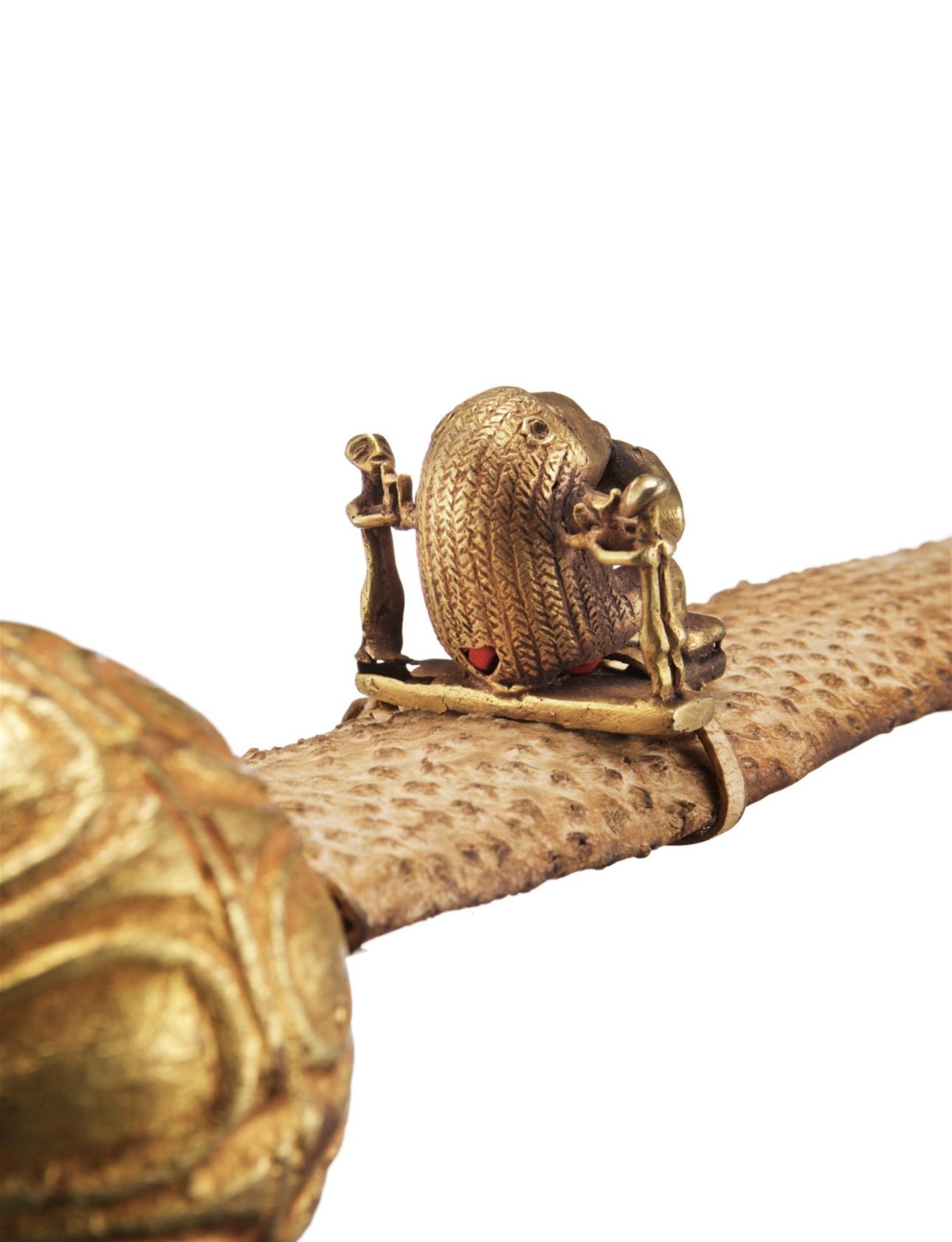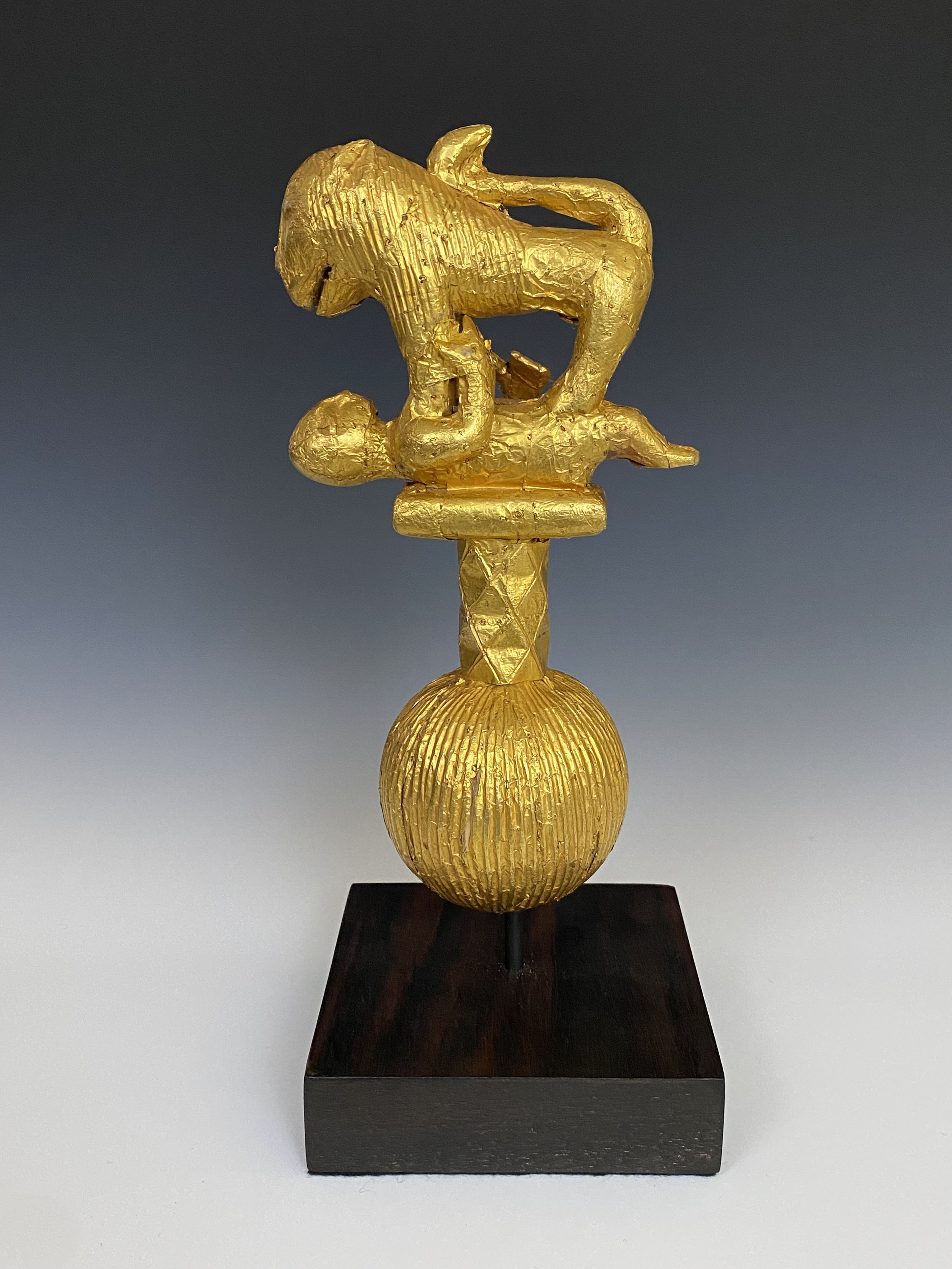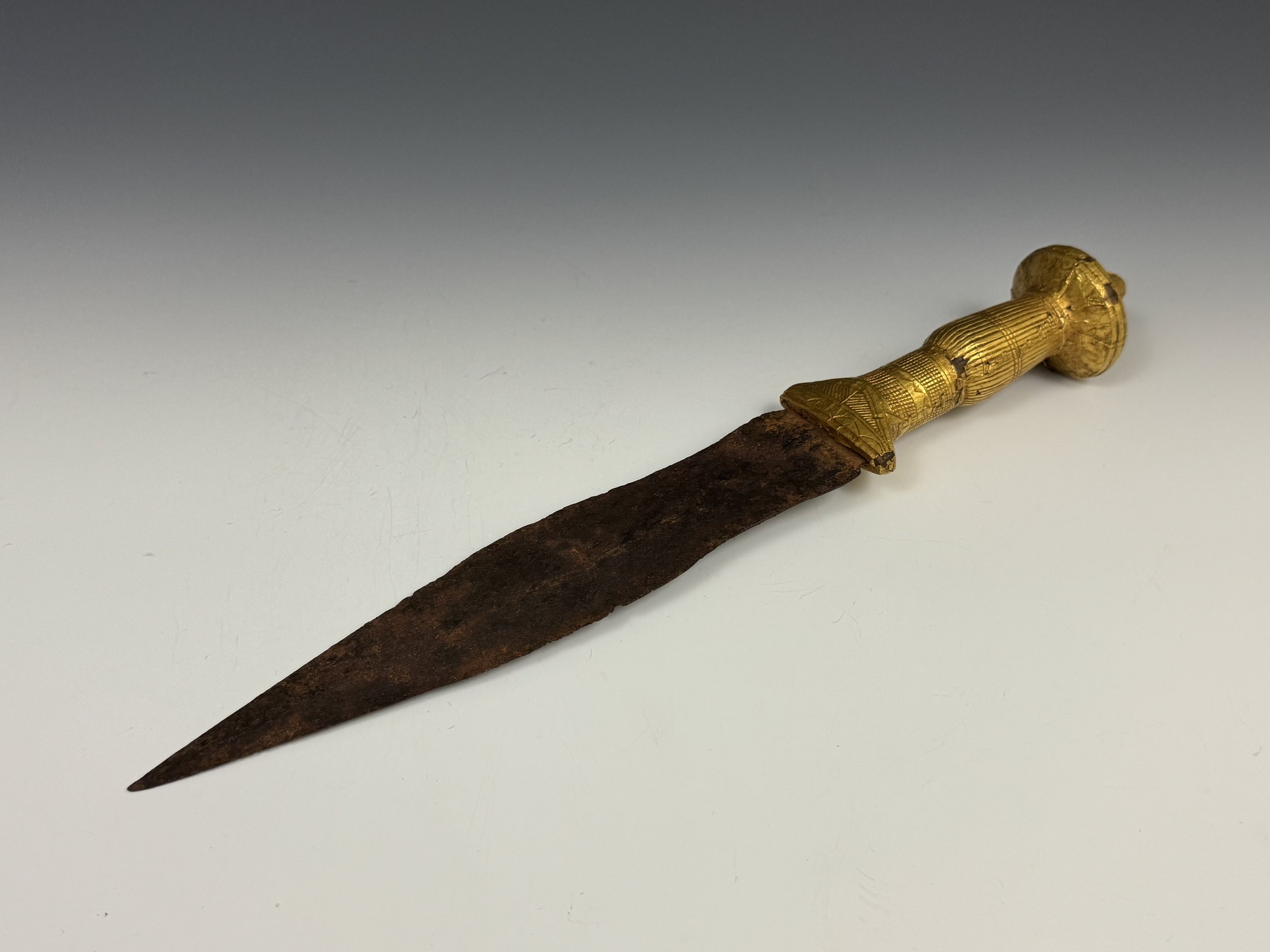Akan and Baule State Swords

Asante State Sword (akrafena) with hide leather sheath and sword ornament (abɔsodeɛ). Wood, gold leaf, hide leather, steel. The sword ornament represents the strength and power of the chief, “The invincible crocodile that swallows bullets.”

Asante sword ornament (abɔsodeɛ), wood, gold foil, Ghana, 12.5” L. A crocodile is one of the most common images found on the state swords of the Asante paramountcies. “A crocodile alone or with a mudfish in its mouth is found at five Asante paramountcies and is given several interpretations. The crocodile at Mampon represents a praise name for the king, “The great crocodile that swallows a stone every year.” Stone is a metaphor for “bullet” and refers to the Mamponhene’s position as a leader of one of the Asante armies. Kyerematen reports that the crocodile on one of the Asantehene’s swords originated with Asantehene Osei Kwadwo (r.1764-177) and represents the “totemic” animal of his paternal (ntɔrc) kin group (1961,13). At Kumawu the crocodile with a mudfish in its mouth as well as a second mudfish, elicits the proverb “when the mudfish swallows anything, it does so for its master,” meaning that the chief automatically benefits from the success of his subjects. (The predatory nature of the crocodile-mudfish relationship is ignored here.) for the combined motif at Kumawu, Quarcoo records a different meaning, “If that species of fish comes from the river to tell you that the crocodile is dead, there is no need to argue about it,” indicating that people who live together know each other’s behavior (1975,16). Yet another interpretation of this image was given at Edweso, “If the crocodile catches the mudfish, it does not deal leniently with it, a reference to the extreme power of both chief and state. This multiplicity of meanings attached to one motif is common in abɔsodeɛ iconography, as in most Akan symbolism. “ - Doran Ross


Asante ceremonial state sword “afena”. Wood, gold foil, steel, ray and animal hide with fur (antelope), leather, white pigment or clay. The sheath has a wood covered with gold foil floral ornament. Swords "afena" were prominently displayed at royal courts as regalia of the king reflecting upon his power and authority. They were held by the ruler during his enstoolment or gripped by subchiefs, who swore their allegiance to him. They were used in a variety of ways. Sword bearers flanked the ruler during processions. They were used to swear oaths ("nsuafena") and as badges of office for messengers or envoys of the king ("asomfofena"). Priests used them during rituals and they were placed in shrines as objects of veneration. L: 70 cm, L: 27,6 inch Provenance: Alexander Kubetz (1946-2023), Munich, Germany Published: Zirngibl, Manfred A. & Alexander Kubetz, "panga na visu", Riedlhütte 2009, p. 37, ill. 50






This is an Asante State sword “afena” from Ghana with a sword ornament cast in 6K gold/silver alloy. The sword hilt is carved wood covered with gold foil. The iron blade has a sheath of ray and antelope hide (front/back). 72cm. The sword ornament (abɔsodeɛ) is an image that appears to be a Baboon eating a cricket or grasshopper. Two small men flank his sides with flint lock rifles. The meaning of this image most likely points to a proverb but more research is needed. Published: Blum, Rudolf (2007). Rudolf and Leonore Blum Collection. Volume 3 A. Zumikon: Self-published. No. 219. Provenance: - Galerie Walu, Zurich. - 1994: Rudolf and Leonore Blum (1919-2009 / 1923-2013), Zumikon. - Hammer Auctions, Zurich, December 3rd, 2016, lot 53. - Swiss private collection, Schwyz.






Akan double-edged ceremonial sword, "afena", Côte d'Ivoire. Wood, covered with gold foil, iron. H 57 cm. Provenance: Estate of René David (1928-2015), Zurich. Exhibited: Musée International du Golfe de Guinée, Togo (2005-2011).




Two small Asante swords “afena”. Wood, steel, gold foil. Ghana. The left sword is a dance sword. “The accessories of an important chief also include a small sword held in the right hand and a horsetail fly whisk in the left. Although not without symbolic value, these are primarily dance implements that extend and amplify the gestures as he is carried and performs in a palanquin on festival occasions.” P.185 Gold of the Akan from the Glassell Collection. The sword on the right appears to be a small sword carried by the gunbearer’s with its uniquely shaped hilt and narrow blade. Asante state swords appear as prestige objects on various official occasions such as the occasion of the enthronement of a new regent or during the purification ceremonies. Ceremonial swords symbolically demonstrate the power and prosperity of the Asantehene (regent of the Asante). They are carried by his sword-bearers and at the same time document the status and rank of the bearer. For example, if the Asantehene takes part in a procession, he is accompanied by numerous sword-bearers, taking the blade of the sword in their hand and pointing the pommel towards the king as a sign of their loyalty. The king himself holds a small sword in his right hand, which he uses as a dance staff and symbolic weapon. Provenance: EX Dr. Andreas Vontobel (1931-2011), Waltalingen, Switzerland


A selection of Akan sculptural gold-covered hilts of the “afenatene” state swords. Wood, gold foil. This class of sword hilts have a large variety of representational images and meanings and are usually held by their steel blades (missing here) to display the proverbial message associated with the hilt. Some examples in this group are “Akokg ntakdra na emd akoko ye kese”, —It is the feathers on a fowl that make it big. (This saying has been heard in the sense that, it is the number of subjects whom a chief has who make him important). Another is "Although the hen knows that the dawn is breaking, she leaves it to the rooster to announce." A hand holding a key can represent “the Chief holds the key to the treasury”. The key also represents a saying ’If I lock it, nobody can open it’ which is a message from parents to children meaning that the parent (or the chief) always has the last say. Another interpretation: Proverbial or literal translation: ‘Being in authority can be likened to a key in one’s hand which if not held properly can lead to lost position. One proverb for a perched bird is: “Anoma anntu a, obua da”. Literally: If a bird does not fly, it goes to bed hungry. You must take action if you want to make a living.

An Asante sculptural sword hilt. Wood, gold foil, Ghana. The steel blade is missing but when brought out for display and festivals, the sword would have been held by the blade, displaying the hilt and its proverbial meaning. A hand holding a key can represent “the Chief holds the key to the treasury”. The key also represents a saying ’If I lock it, nobody can open it’ which is a message from parents to children meaning that the parent (or the chief) always has the last say. Another interpretation: Proverbial or literal translation: ‘Being in authority can be likened to a key in one’s hand which if not held properly can lead to lost position. EX Hemingways, New York

I believe this represents a vulture or “Opete”. There are many Asante proverbs associated with the vulture and it also symbolizes self-begetting, self-creation, and self-birth. It is the animal that symbolizes Odomankoma, the Akan deity who created the world. Regardless of which type of bird it represents, one proverb for a perched bird is: “Anoma anntu a, obua da”. Literally: If a bird does not fly, it goes to bed hungry. You must take action if you want to make a living. EX Hemingway's New York




EX René David, Zurich, Switzerland

Estate René David (1928-2015), Zurich


An exceptional Akan sculptural sword handle from coastal Ghana, Shama region. (Carved wood covered with heavy gold foil and gold staples). The image is of a lion standing on top of a fallen man. The proverb usually associated with this image is “When the lion captures the hunter, the gun is useless.” In most states the chief identifies with the lion, and the image is a symbol of victory with the implication that it is over superior forces. An alternate proverb for this image argues that “It is better not to have fired at all, than to have fired and missed the lion” (cf. Ross 1982a, fig. 3).” Here the message is more about the judicious use of power and exercising it with some care.“(D. Ross)




A coastal Akan sculptural sword handle with an image of a dwelling surrounded by animals on both sides. (Chief’s regalia from the Shama region of Ghana, west of Cape Coast). Carved wood, hammered gold foil. More research has to be done to identify the proverb associated with this image. Currently, I haven’t found another motif similar to this one. A possible proverb that could describe this image (at least to my interpretation) is “Aboa bi beka wo a, na ofiri wo ntoma mu”: Literally: If an animal will bite you, it will be from your cloth. This saying is seen in a sense that it is likely that the people who will harm you are those close to you because it is those who are closest to you that know best how to hurt you the most. This proverb can be used to counsel someone who has been hurt by a close associate, even a relative. In that case, it advises that the one hurt should let things go. However, it could also advise one to be wary of his close associates because they are the very ones who are likely to hurt him, rather than some supposed enemies.





An intricately carved hilt of a Baule state sword displaying the talents of the highly accomplished artisan. Most of the gold foil is missing with slight gold foil remnants remaining. 42 inches L. Ex Bonhams San Francisco, Ex Estate of Phyllis Weinstein.



A Baule chief’s prestige knife in an animal hide sheath adorned with a spondylus shell. The knife handle is made of carved wood covered with gold foil which is carefully attached with hammered flat gold staples made of the same gold foil. The blade is forged steel. Côte d’Ivoire. 35cm H





Akan state swords like this one are more ceremonial and symbolic of an instrument of power and are always carried by the “blade”. The sword blade here depicts imagery of wisdom knots, crocodiles, and other Akan symbols. The sculptural hilt is a highly realistic carving of a tortoise on top of a giant snail shell connected by a wisdom knot. This image combination is often seen in “mptea” or royal chief rings with a snail shell and a rifle on top of a tortoise shell. One proverb for this imagery is “If it were only for the snail and the tortoise, the gun would not fire in the forest.” The wood hilt has a very aged patina and at one point would have been completely covered with thick gold foil and gold staples which still covers various small sections such as the tortoise’s head. There are many gold staples still left in the wood but the majority have been removed and probably recycled into newer designs or sold for gold value. The wood still bears the holes of the small gold staples used to attach the gold sheet. Another carving would have been on top of the tortoise and is now broken off and missing- possibly a rifle. The hilt is removable from the blade so I chose to display this on a separate base for now due to size restraints. This sword came from the estate of the NYC artist Philip Martin Pearlstein (1924-2022). Pearlstein was a modernist portrait and still life painter that went to school at the Carnegie Institute and moved to NYC and shared an apartment together with his friend and fellow student, Andy Warhol. His works are in most major collections and museums.







This photo is from Pearlstein's studio which shows this particular sword in the background.

An Akan sculptural sword hilt carved of wood and covered with gold foil and gold staples. 23 cm. Ghana. The image consist of two heads on top of two gunpowder keg barrels- a reference to the power of the state and chief.




Baule prestige object of a miniature sword carved of wood. Côte d’Ivoire. 29.5 cm. This item is a skeuomorph, an item made to look like the original item but out of another material and in this case, carved wood instead of steel. It’s function is to display status, rank, and the power of the bearer. Ex Helmut (1931-2021) and Marianne Zimmer, Zurich.



A pair of Baule knives with gold foil covered wood handles, in a double leather sheath embellished with braided motifs. These gold-leafed knives, called laliɛ blawa, form part of a chief's accoutrements. A similar pair is illustrated in Ratton, 1951, fig. 109 and also a similar item is in the collection "Gold of Africa", Barbier-Mueller Museum in Cape Town, fig, 71, description pg 244. They represent the Baule proverb: Laliɛ kungba gbe kla fa se men i bɔbɔ i waka. The blade of a knife cannot carve its own handle. (A second knife is necessary to carve a handle for the first. What you cannot do alone, you can achieve through co-operation.) Côte d’Ivoire #mooscollection




A fine older Asante state sword “Akrafena” with intricately carved designs on handle covered in gold foil. The incised steel blade is decorated on one side. 28 inches long.

